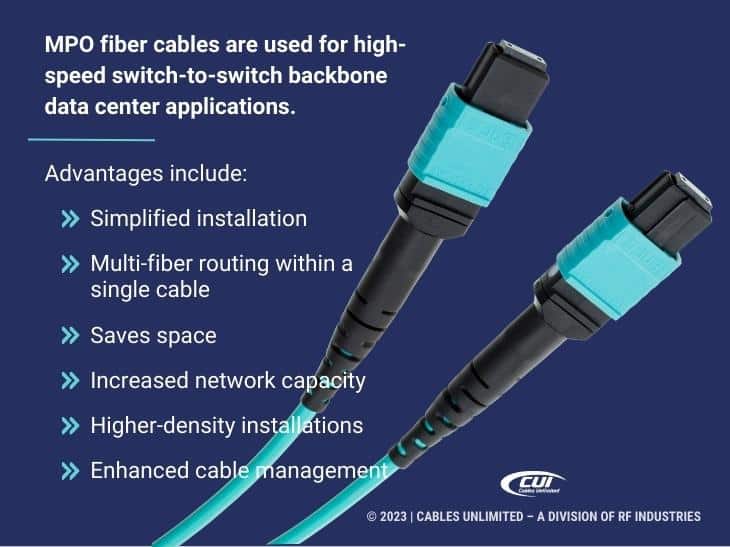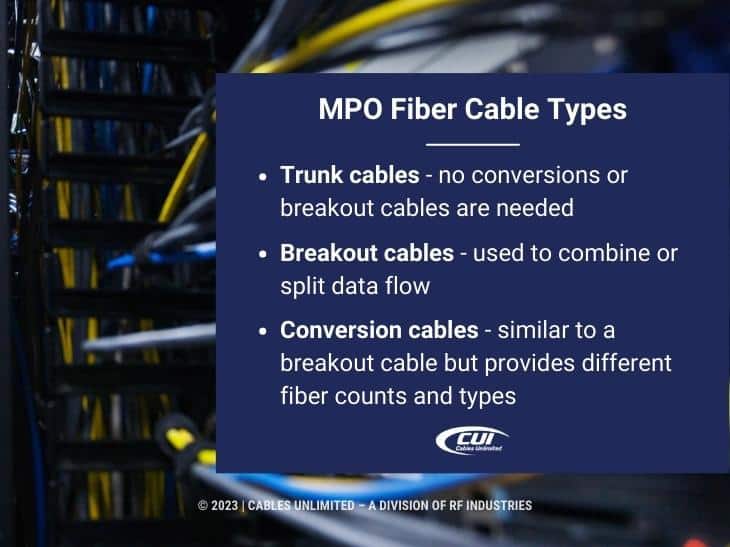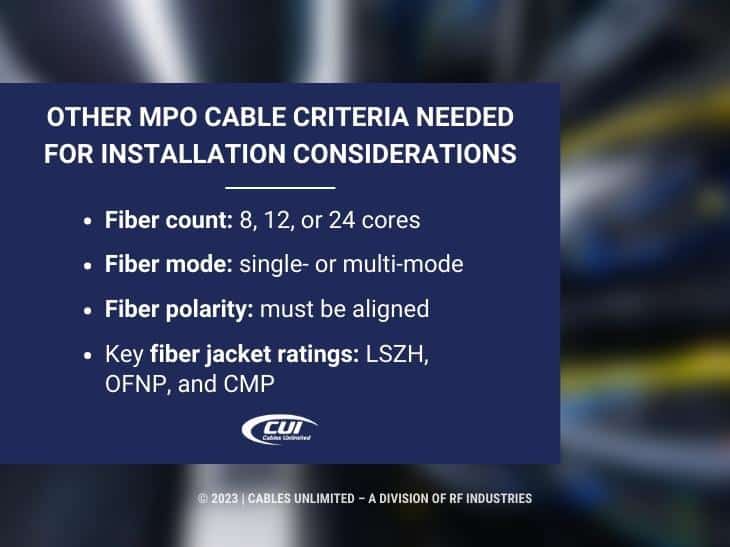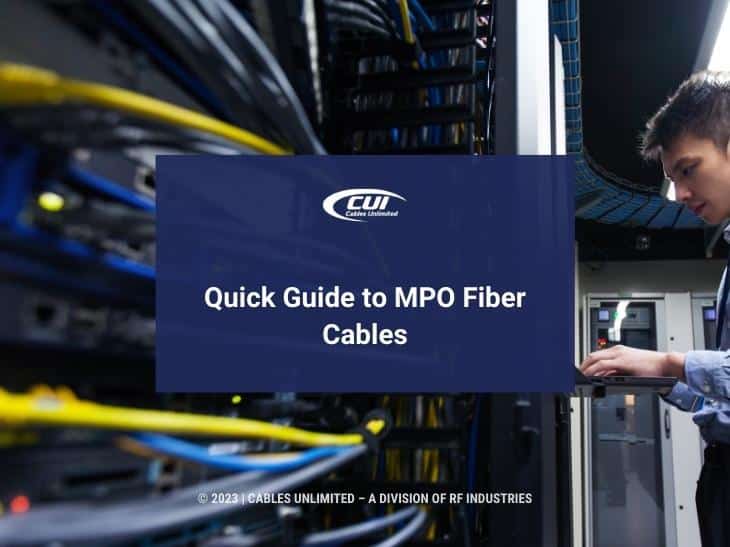Increased bandwidth and rapidly expanding data centers have driven the push from traditional dual-fiber patch cable to MPO fiber cable. This article defines MPO cables, discusses their applications and advantages, and digs further into types and other essential criteria.
What Are MPO Cables?
MPO stands for Multi-Fiber Push-On cable connectors. There is also an MTP® cable connector, an advanced MPO cable with improved mechanical and optical performance. MPO and MTP® cables are fully compatible. Both fiber optic cables are standardized and pre-terminated, allowing a broad range of applications.
MPO cables are defined as array connectors with more than two fibers. They are typically available with 8, 12, or 24 fibers. They are also available for super high-density multi-fiber arrays with fiber counts ranging from 32 to as high as 144.

MPO Cable Applications and Advantages
MPO fiber cables are used for high-speed switch-to-switch backbone data center applications. As one example, an eight-fiber cable supports four fibers transmitting and four receiving. Speeds range from 10 to 25 Gbps, with expected improvements up to 200 and 400 Gbps. They are also used in Local Area Network (LAN) installations.
Their advantages stem largely from simplified installation and multi-fiber routing within a single cable. That saves space allowing increased network capacity, leading to higher density installations, and greatly enhancing cable management.
MPO Fiber Cable Types
There are several MPO cable types for specific applications. Here’s a quick overview of the different types.
- Trunk Cables. These fiber trunk cables have the same type and amount of connectors at both ends, so no conversions or breakout cables are needed. MPO fiber cables are perfect for high-density, high-speed, and very low signal-loss applications.
- Breakout Cables. This type of MPO cable is used to combine or split data flow. Examples include splitting a single signal into four strands or eight strands to direct the signal wherever it’s needed efficiently. This simplifies the data center topology and reduces the equipment count.
- Conversion Cables. This cable type is similar to a breakout cable but provides different fiber counts and types. A typical conversion cable runs a 24-fiber cable to 2×12 or 3×8 fiber. This approach eliminates the need for separate breakout cables to improve the flexibility of the cabling system.

Other MPO Cable Criteria
Those are the major MPO cable types, but our discussion wouldn’t be complete without examining the other MPO cable criteria needed for installation considerations.
- CounFibert. As stated above, fiber counts are typically 8, 12, or 24 cores. Eight-fiber MPO cables provide the same data rates as standard 12-fiber cables and, as a result, offer lower cost and lower insertion loss.
- Fiber Mode. MPO cables offer single-mode OS2 and multimode OM3/OM4. OS2 cables are best for long-distance transmission up to 200 km. OM3 runs up to 100 meters and OM4 up to 150 meters, making them best for buildings and campus installations.
- Fiber Polarity. It’s essential with any fiber installation that the cable polarities are aligned. Proper polarity means that the optical transmitter at one end is connected to the optical receiver at the opposite end. Type-A patch cords are straight-through connections. Type-B patch cords are cross-over connections with pin 1 routed to pin 12 in a typical 12-fiber cable. Type C is a cross-pair connection with pin 1 routed to pin 2 and so on in a paired connection.
- Fiber Jacket Rating. MPO cable jackets come in a variety of ratings. The key ones are LSZH (low smoke, zero halogen), which protects people from toxic fumes during combustion; OFNP (optical fiber nonconductive), that have the highest fire rating; and CMP (communications multipurpose cable plenum), which restricts flames and smoke during a fire. The last two can be installed in ducts and plenum spaces.
Read more in our article: Single-Mode Fiber: Why It’s the Go-To Solution for Enterprise Networks.

We Can Help with Your MPO Fiber Cable Selection
We’ve got you covered for MTP®/MPO cables, as well as a complete range of fiber optic cables, including DAS cables, trunk cables, patch cables, macro cables, small cell cables, OptiFlex™ Hybrid Composite Cables, IP outdoor rated cable assemblies, and custom fiber optic cables.
If your requirements are already specified and ready for a quote for your current projects, we are prepared to meet your deadlines and pricing targets. Our extensive in-house services and advanced manufacturing capabilities are in place to meet your requirements.
But Cables-Unlimited offers much more than state-of-the-art manufacturing – our dedicated team is also known for going to great lengths to meet the needs of our customers, including working round-the-clock to meet tight turnaround time requirements.
Our sales representatives are standing by to assist you with product questions and quotes Monday – Friday, 8:00 am to 5:00 pm Eastern. You can also send us an email or complete our contact form, and we’ll get right back to you.




